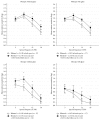Long-Term Clinical Outcomes after Mix and Match Implantation of Two Multifocal Intraocular Lenses with Different Adds
- PMID: 30755802
- PMCID: PMC6348908
- DOI: 10.1155/2019/6789263
Long-Term Clinical Outcomes after Mix and Match Implantation of Two Multifocal Intraocular Lenses with Different Adds
Abstract
Purpose: To compare long-term clinical outcomes between patients with bilateral implantation of +3.0 diopter (D) multifocal intraocular lenses (IOLs) and mix and match implantation of +2.5 D and +3.0 D multifocal IOLs.
Material and methods: This retrospective observer-masked cohort study comprised 66 eyes of 33 patients with two different strategies of binocular multifocal IOLs implantation: bilateral +3.0 D (17 patients) (bilateral group) and mix and match +2.5 D and +3.0 D (16 patients) (blended group). Patients were recruited 1 year (±3 months) after second-eye surgery. The primary effectiveness endpoint was binocular uncorrected intermediate visual acuity (UCIVA) at 70 cm. The secondary assessments included binocular visual quality tests and quality-of-vision questionnaire.
Results: The blended group showed clinically better UCIVA (0.10 ± 0.07 logMAR) at 70 cm than the bilateral group (0.26 ± 0.09 logMAR) with a difference of 0.16 ± 0.08 logMAR (P < 0.001). Similar binocular visual acuities were achieved between the two groups at the near and far distance. The binocular defocus curves showed better performance in the blended group from 50 cm to 1 m. The mean binocular contrast sensitivities under the photopic conditions with or without glare and mesopic condition without glare were clinically better in the blended group. Both the groups reported low rate of visual phenomena, high rate of spectacle independence, and satisfaction.
Conclusions: Comparing with bilateral implantation of +3.0 D multifocal IOLs during the cataract surgery, mix and match implantation of +2.5 D and +3.0 D multifocal IOLs provides a wider depth of binocular focus, especially for intermediate distances, and better binocular visual quality.
Figures



Similar articles
-
Clinical outcomes after mix-and-match implantation of diffractive multifocal intraocular lenses with + 2.75 and + 4.00 diopter add powers.BMC Ophthalmol. 2020 May 15;20(1):193. doi: 10.1186/s12886-020-01460-7. BMC Ophthalmol. 2020. PMID: 32414339 Free PMC article.
-
Comparison of Visual Performance Between Mix-and-Match and Bilateral Implantation of Rotationally Asymmetric Multifocal Intraocular Lenses.Clin Ophthalmol. 2024 Nov 18;18:3289-3295. doi: 10.2147/OPTH.S487162. eCollection 2024. Clin Ophthalmol. 2024. PMID: 39582497 Free PMC article.
-
Short term visual outcomes of a new trifocal intraocular lens.BMC Ophthalmol. 2017 May 17;17(1):72. doi: 10.1186/s12886-017-0462-y. BMC Ophthalmol. 2017. PMID: 28514944 Free PMC article.
-
Effectiveness of multifocal and monofocal intraocular lenses for cataract surgery and lens replacement: a systematic review and meta-analysis.Graefes Arch Clin Exp Ophthalmol. 2019 May;257(5):863-875. doi: 10.1007/s00417-018-04218-6. Epub 2019 Jan 10. Graefes Arch Clin Exp Ophthalmol. 2019. PMID: 30627791
-
[Multifocal intraocular lenses--an assessment of current status].Klin Monbl Augenheilkd. 1993 Jul;203(1):19-33. doi: 10.1055/s-2008-1045645. Klin Monbl Augenheilkd. 1993. PMID: 8411889 Review. German.
Cited by
-
Ocular dominance in cataract surgery: research status and progress.Graefes Arch Clin Exp Ophthalmol. 2024 Jan;262(1):33-41. doi: 10.1007/s00417-023-06216-9. Epub 2023 Aug 30. Graefes Arch Clin Exp Ophthalmol. 2024. PMID: 37644327 Review.
-
Comparison of binocular visual quality in six treatment protocols for bilateral cataract surgery with presbyopia correction: a prospective two-center single-blinded cohort study.Ann Med. 2023;55(2):2258894. doi: 10.1080/07853890.2023.2258894. Epub 2023 Sep 21. Ann Med. 2023. PMID: 37734409 Free PMC article.
-
Clinical Outcomes of Combined Implantation of an Extended Depth of Focus IOL and a Trifocal IOL in a Korean Population.J Ophthalmol. 2021 Sep 7;2021:9034258. doi: 10.1155/2021/9034258. eCollection 2021. J Ophthalmol. 2021. PMID: 34540288 Free PMC article.
-
Rainbow halos occur less following implantation of extended range of vision one-piece intraocular lenses vs diffractive bifocal intraocular lenses.Int J Ophthalmol. 2020 Jun 18;13(6):913-919. doi: 10.18240/ijo.2020.06.09. eCollection 2020. Int J Ophthalmol. 2020. PMID: 32566502 Free PMC article.
-
Cost-Effectiveness of Presbyopia Correction Among Seven Strategies of Bilateral Cataract Surgery Based on a Prospective Single-Blind Two-Center Trial in China.Ophthalmol Ther. 2022 Dec;11(6):2067-2082. doi: 10.1007/s40123-022-00562-3. Epub 2022 Sep 7. Ophthalmol Ther. 2022. PMID: 36071311 Free PMC article.
References
-
- Agresta B., Knorz M. C., Kohnen T., Donatti C., Jackson D. Distance and near visual acuity improvement after implantation of multifocal intraocular lenses in cataract patients with presbyopia: a systematic review. Journal of Refractive Surgery. 2012;28(6):426–435. doi: 10.3928/1081597x-20120518-06. - DOI - PubMed
LinkOut - more resources
Full Text Sources

